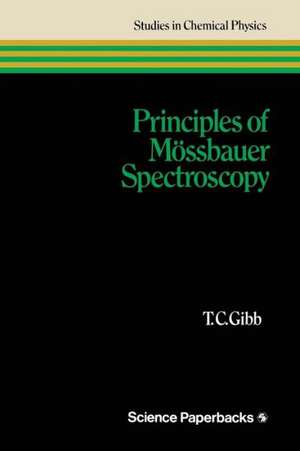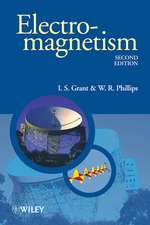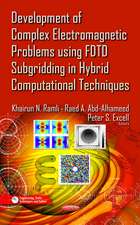Principles of Mössbauer Spectroscopy: Studies in Chemical Physics
Autor Terence Gibben Limba Engleză Paperback – 2 oct 1980
Preț: 386.39 lei
Nou
Puncte Express: 580
Preț estimativ în valută:
73.94€ • 77.04$ • 61.22£
73.94€ • 77.04$ • 61.22£
Carte tipărită la comandă
Livrare economică 03-17 aprilie
Preluare comenzi: 021 569.72.76
Specificații
ISBN-13: 9780412230608
ISBN-10: 0412230607
Pagini: 254
Ilustrații: VIII, 254 p.
Dimensiuni: 155 x 235 x 14 mm
Greutate: 0.38 kg
Ediția:1976
Editura: SPRINGER NETHERLANDS
Colecția Springer
Seria Studies in Chemical Physics
Locul publicării:Dordrecht, Netherlands
ISBN-10: 0412230607
Pagini: 254
Ilustrații: VIII, 254 p.
Dimensiuni: 155 x 235 x 14 mm
Greutate: 0.38 kg
Ediția:1976
Editura: SPRINGER NETHERLANDS
Colecția Springer
Seria Studies in Chemical Physics
Locul publicării:Dordrecht, Netherlands
Public țintă
ResearchCuprins
1 The Mossbauer Effect.- 1.1 Resonant absorption and fluorescence.- 1.2 The Mossbauer effect.- 1.3 The Mossbauer spectrum.- 1.4 The Mossbauer spectrometer.- 1.5 Mossbauer isotopes.- 1.6 Computation of data.- References.- 2 Hyperfine Interactions.- 2.1 The chemical isomer shift.- 2.2 Magnetic hyperfine interactions.- 2.3 Electric quadrupole interactions.- 2.4 Combined magnetic and quadrupole interactions.- 2.5 Relative line intensities.- References.- 3 Molecular Structure.- 3.1 Iron carbonyls and derivatives.- 3.2 Geometrical isomerism in Fe and Sn compounds.- 3.3 Linkage isomerism in cyano-complexes of Fe.- 3.4 Conformations in organometallic compounds of Fe.- 3.5 Stereochemistry in tin compounds.- 3.6 Molecular iodine compounds.- Appendix Quadrupole splitting in cis- and trans-isomers.- References.- 4 Electronic Structure and Bonding: Diamagnetic Compounds.- 4.1 Formal oxidation state.- 4.2 Iodine.- 4.3 Tellurium and antimony.- 4.4 Tin.- 4.5 Covalent iron compounds.- References.- 5 Electronic Structure and Bonding:Paramagnetic Compounds.- 5.1 Quadrupole interactions.- 5.2 Magnetic hyperfine interactions.- 5.3 Spin cross-over.- 5.4 Pressure effects.- 5.5 Second and third row transition elements.- 5.6 Lanthanides and actinides.- References.- 6 Dynamic Effects.- 6.1 Second-order Doppler shift and recoilless fraction.- 6.2 The Gold an skii-Karyagin effect.- 6.3 Electron hopping and atomic diffusion.- 6.4 Paramagnetic relaxation.- 6.5 Superparamagnetism.- References.- 7 Oxides and Related Systems.- 7.1 Stoichiome tric spinels.- 7.2 Non-stoichiometric spinels.- 7.3 Exchange interactions in spinels.- 7.4 Rare-earth iron garnets.- 7.5 Transferred hyperfine interactions.- References.- 8 Alloys and Intermeiallic Compounds.- 8.1 Disordered alloys.- 8.2 Intermetallic compounds.- References.- 9 Analytical Applications.- 9.1 Chemical analysis.- 9.2 Silicate minerals.- 9.3 Surface chemistry.- References.- 10 Impurity and Decay After-effect Studies.- 10.1 Impurity doping.- 10.2 Decay after-effects.- References.- 11 Biological Systems.- 11.1 Haemoproteins.- 11.2 Ferredoxins.- References.- Observed Mossbauer Resonances.

















